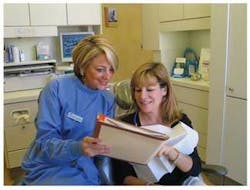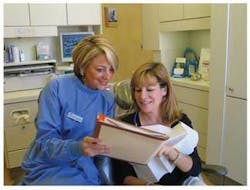Measuring the value
You probably know by now that the focus of my practice is my patients. Providing them with the best diagnostic capabilities and treatment strategies and ensuring their comfort during appointments is my top priority. At the same time, I am also a business owner, responsible for making the financial decisions that keep me in a position to care for my patients in a way that is rewarding for me.
We hear a lot about ROI (return on investment) these days. While it is important to obtain a financial payback from investments in my practice, this is only one aspect. Just as important is that these investments enable me to improve patient care. When faced with the decision to invest in equipment, I ask myself two questions: ➊ Will this benefit my patients? ➋ Does it make financial sense? Then, I weigh the information carefully. The choice to implement digital radiography was one of those instances where - after doing my homework - I found the answer to both questions was yes.
Knowing that digital radiography provides measurable return, I took a logical approach to computing the costs of taking film-based X-rays. Using my practice-management software, I calculated the number of X-rays I took in my practice in a typical month. By the time I added up the number of full-mouth series, two- and four-film bitewing series, and periapicals for all types of procedures, I learned that my average was 766 films per month. I also added up the cost of the film itself, chemicals, mounts, hazardous waste disposal fees, and processor cleaning supplies for the same period and came up with a total of $429 per month.
I also had to consider time in this research. I averaged my assistants’ time at $26 per hour. When I calculated the time they spent putting film into the processor and mounting the X-rays, from one minute for a PA to 14 minutes per FMX, plus the time for monthly cleaning of the processor, my totals came to $464 a month.
With expendable product and time costs of more than $900 per month and a lease of well below $400 per month, it became apparent that even if there were no other benefits, I could save at least $6,000 a year by converting to digital radiography! I also looked at it this way: With consumables, it’s just that, consumed. I could pay for film the rest of my career and never acquire a financial gain. But with equipment that I own, I do achieve a gain.
In considering the other “gain” in the equation - that is, how digital radiography would benefit my patients - I knew I would have better diagnostic ability with digital. That, in itself, made the investment a wise one. It was only after I switched to digital that I experienced an important return I had not anticipated - the return of improved relationships that digital radiography enabled me to build with my patients.
Digital radiography is a trust builder. One of the most important things any dentist or dental team member does is get to know the patients, spend time talking with them, listen to their concerns, and build their confidence in our ability to make their experience and outcomes better.
With digital radiography, my team and I don’t have to abandon our patients to run to the darkroom. We don’t have to attend to another matter as we wait for film to be developed in the middle of what they consider to be “their” appointment time. We have more time to spend with patients, often reviewing X-rays, but just as often simply building their confidence and trust. For me, in my patient-centered practice, digital radiography offers so much more than a simple financial return.
So, digital radiography met my criteria of a sound investment in both economic and patient benefits. And yes, it took some time to evaluate those details. It all started with my willingness to wear my businesswoman’s “hat.” It’s a given that we, as caregivers, must have patients to keep our practices viable. But we, as business owners, must also have the patience to make smart financial decisions.Cynthia Brattesani, DDS, maintains a private practice in San Francisco. She won the prestigious ADA Golden Apple New Dentist Leadership Award in 1996. She is an enthusiastic member of organized dentistry, having held positions at the local, state, and national levels. You may reach her at [email protected].

